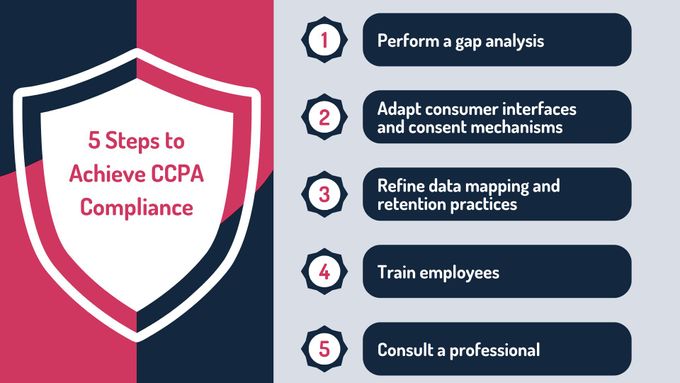Already GDPR Compliant? Here's How to Tackle CCPA Requirements
Explore the differences between GDPR and CCPA and discover how to adapt GDPR compliance efforts to meet CCPA standards. Learn practical steps to align your policies, data practices, and consumer rights management for seamless compliance and protection against fines and reputational risks.
Published April 5, 2025.

In recent years, data breaches and privacy scandals have become increasingly common, with millions of consumer records exposed and trust in organizations eroding. One such example is the 2019 Capital One data breach, which compromised the sensitive information of over 100 million customers and cost the company over $190 million in fines and settlements.
When the California Consumer Privacy Act (CCPA), came into effect in 2020, it marked a pivotal moment in US data privacy law, impacting businesses far beyond California. With global regulations evolving, good compliance remains a critical priority. Organizations failing to meet these requirements risk hefty fines, reputational damage, and customer distrust. For businesses already compliant with Europe’s General Data Protection Regulation (GDPR), the quickest way to be CCPA compliant is to leverage existing frameworks.
» Skip to the quickest CCPA compliance solution: Professional privacy regulation compliance
Which Organizations Must Comply With the CCPA?
The California Consumer Privacy Act (CCPA) applies to for-profit businesses that operate in California and meet specific thresholds, including:
- Generating annual revenues exceeding $25 million.
- Handling the personal data of 50,000 or more California residents, households, or devices.
- Earning 50% or more of their annual revenue from selling California consumers' personal data.
Importantly, businesses do not need a physical presence in California to fall under the CCPA's jurisdiction; simply engaging with California consumers or processing their data is sufficient to require compliance.
» Going international? Here's what you need to know
CCPA vs. GDPR Compliance: 3 Key Differences
1. Scope
The GDPR applies broadly, covering any organization that processes the personal data of EU residents, regardless of where the company is based. This means even non-EU businesses must comply if they interact with EU consumers or handle their data. It is designed to protect the data of all EU citizens, no matter where the data is processed.
In contrast, the CCPA specifically targets for-profit businesses operating in California or serving Californian consumers. The regulation applies to organizations meeting certain thresholds, such as annual revenues above $25 million or handling data of 50,000 or more Californian residents. Businesses must focus on mapping and managing data related to California residents specifically.
» Find out why the GDPR is the biggest thing since SOX
2. Privacy Policies
The GDPR requires businesses to create detailed privacy policies that clearly outline how consumer data is collected, stored, processed, and shared. These policies must also include information about consumer rights, such as data access and deletion, and be written in plain, accessible language.
Under the CCPA, privacy policies must be updated annually to ensure they reflect current data practices. While the formatting requirements are less stringent than those under the GDPR, businesses must still clearly inform consumers about their rights under the CCPA, such as the ability to opt out of data sales.
3. Consumer Rights
The GDPR prioritizes an opt-in model for data collection, requiring organizations to obtain explicit consent from consumers before gathering or using their personal data. This ensures consumers are fully informed and actively agree to data processing practices.
The CCPA, on the other hand, adopts an opt-out model, allowing consumers to request that their data not be collected, shared, or sold. Businesses must include mechanisms, such as a “Do Not Sell My Personal Information” link, to comply with this requirement and give Californians control over their data.
» Learn more: GDPR vs. CCPA vs. TXPPA
| Category | GDPR | CCPA | Practical Action |
|---|---|---|---|
| Scope | Applies to any organization processing the personal data of EU residents, regardless of location | Targets for-profit businesses operating in California or handling data of Californian residents | Map data processes specific to Californian consumers, building on existing GDPR data mapping efforts |
| Privacy Policies | Requires detailed privacy policies outlining data use, storage, and consumer rights | Demands annual updates to privacy policies, with less emphasis on formatting requirements | Leverage GDPR-compliant privacy policies but establish an annual review process to meet CCPA requirements |
| Consumer Rights | Focuses on an opt-in model requiring explicit consumer consent for data collection | Adopts an opt-out model allowing consumers to request stopping data collection or sales | Modify GDPR opt-in mechanisms by adding an opt-out feature tailored to California consumers |
Leveraging GDPR Compliance for CCPA Success
For organizations already navigating the complexities of the GDPR, CCPA compliance might seem like another hurdle. However, the two regulations share many similarities, particularly in the areas of data privacy and consumer rights. By leveraging your existing GDPR infrastructure, you can streamline the process of becoming CCPA-compliant
Here's what to do:
1. Perform a Gap Analysis
While the GDPR and CCPA share common ground, there are distinct differences. A comprehensive gap analysis will help you identify the specific areas where your existing compliance measures need to be enhanced. Key areas to focus on include:
- Scope of application: Determine whether your business activities and target audience fall within the scope of CCPA.
- Consumer rights: While both regulations grant consumers several rights, there are nuances in the specific rights and obligations. Ensure your processes align with CCPA's requirements for data access, deletion, and portability.
- Data minimization: Review your data collection practices to ensure that you are only collecting and processing the data necessary for your business operations.
- Data security: Assess your existing security measures to ensure they meet CCPA's stringent data security standards.
2. Adapt Consumer Interfaces and Consent Mechanisms
- Update privacy notices: Modify your privacy notices to explicitly address CCPA requirements, including the specific categories of personal information collected, the purposes for which the data is used, and the categories of third parties with whom the data is shared.
- Enhance cookie banners: Customize your cookie banners to comply with CCPA's "Do Not Sell My Personal Information" (DNSMPI) requirements. Provide clear and conspicuous opt-out options for California consumers.
- Implement robust consent management: Ensure that your consent management tools can effectively capture and manage consumer consent preferences, particularly for CCPA-specific rights like the right to opt out of the sale of personal information.
3. Refine Data Mapping and Retention Practices
Review and update your existing data maps to accurately reflect the types of personal information collected about California consumers. Implement procedures to securely delete or anonymize personal information that is no longer needed to optimize data retention policies that align with GDPR and CCPA requirements.
4. Train Employees
Develop targeted training programs to educate employees about the specific nuances of CCPA, including California consumers' rights and the potential penalties for non-compliance. Additionally, conduct regular compliance audits to identify and address potential issues.
» Need more help? Here's our guide to preparing for CCPA compliance
5. Consult a Professional
If you self-maintain your CCPA compliance, you'll have to stay informed by monitoring the California Attorney General's Office for updates, guidance, and enforcement actions. This can be time-consuming and difficult to ensure.
Instead, consider partnering with experts in the cyberservices field who can maintain your CCPA compliance for you. Professional privacy regulation compliance services are the quickest way to be CCPA compliant as they can help you maintain trust with your clients by guiding you through the compliance process and ensuring your security by following all the necessary steps to future-proof you for new regulations.
Achieving CCPA Compliance With GDPR
While GDPR compliance offers a head start, achieving CCPA compliance requires targeted updates to your policies, procedures, and practices. The good news is that businesses already committed to GDPR principles can leverage much of their existing framework to meet CCPA’s standards.
By conducting a thorough gap analysis, streamlining processes, and investing in compliance expertise, organizations can ensure they remain compliant and ready for the future of data privacy.
» Let GRSee Consulting simplify the process: Contact us for expert privacy regulation compliance





